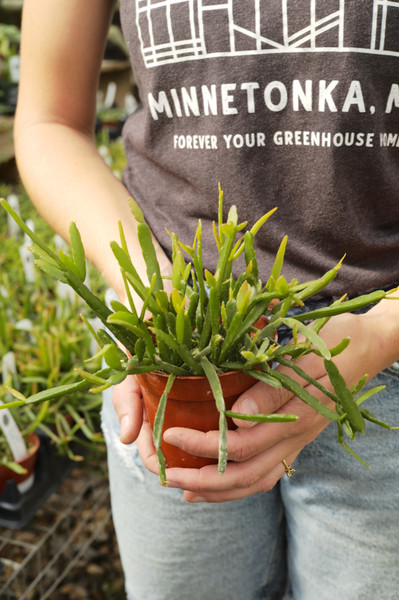Rhipsalis paradox
Posted by Hannah Brand on Sep 29th 2024
Weekly Plant Chat: Rhipsalis paradox
Hey Plant Friends!
This week we are talking about Rhipsalis paradoxa, commonly referred to as mistletoe cactus This variety is known for its green, cascading, non-spikey foliage that resembles chain links, making it a great hanging plant. There are over 40 different varieties of Rhipsalis to collect. With proper care this plant will reward you with adorable, little, white flowers that form transluscent berries which resemble, you guessed it, mistletoe!
Family of Origin
Rhipsalis paradox is an epiphytic plant belonging to the Cactaceae or cactus plant family and is native to Brazil.
Plant Care
Light
Rhipsalis grow on and beneath the trees in their natural habitat. Dappled light throughout the day is perfect. Place in a window that receives good, filtered light especially throughout the winter months.
Soil
When it's time to repot, use a sharp, well-draining potting soil. We recommend Sol Soils Cactus Gritty Mix. This mix has a unique combination of coconut husk chips, recycled forest products, pumice, calcined clay, granite, and expanded clay for optimal drainage.
Water
Allow soil to dry almost completely before giving it a good soak. Never allow your plant to sit in standing water as this can lead to root rot. Cut back on water during the winter months as light levels decrease.
Fertilizer
Fertilize with a cactus specific fertilizer. We recommend Schultz Liquid Cactus Plant Food. As growth slows in the winter months, fertilize at half strength.
Hot Tips
Keep an eye out for common pests such as mealy bugs, scale, and spider mites. Check for pests weekly while watering and keep a bottle of Bonide’s Insecticidal Soap on hand for easy treatment.
Treat rhipsalis more like a succlent than a cactus. They actually require less light than succulents and cactus and more water!
Rhipsalis are non-toxic to our furry friends.
Shop Now!
Rhipsalis paradoxa are available in 4” pots in the greenhouse.
Always approachable and happy to help!

